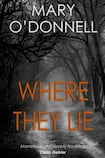
‘She called them norths, plural, because they were multiple as demons possessing a soul.” Northern Ireland’s troubled history haunts Gerda McAllister, the middle-aged journalist at the centre of Where They Lie (New Island, €13.99).
The truth eludes this secular Protestant, who is desperate to find out more about the murders of her best friends, Harry and Sam Jebb. Closure is not easy in post-Good Friday agreement Belfast. The bodies of the twin brothers have never been found. They were “disappeared” some years back, latecomers to a system of violent retribution employed at the height of the Troubles to punish and instil fear in alleged informers.
In real life the Disappeared officially refers to 16 people who vanished in Northern Ireland. Nine of the victims' bodies have been recovered, and investigations are ongoing. This book was published in May, the month Gerry Adams was questioned about the murder in 1972 of Jean McConville, one of the highest-profile cases; the body of the widowed mother of 10 was found in 2003.
For a novelist it is interesting terrain. Mary O'Donnell is fictionalising a crime that happened in reality, but a reality that is suspended. No body, no responsibility, no punishment, no closure: a never-ending story. It takes a brave and assured writer to tackle such a subject. O'Donnell has published seven collections of poetry and six works of fiction. Her previous novels include her acclaimed debut, The Light-Makers, and The Elysium Testament.
Closure
The theme of closure permeates her new novel. Each of the four main characters is struggling for resolution. The twins’ younger sister, Alison, yearns for a baby as she approaches 40; her fervent prayers at Kingdom Hall have so far gone unanswered. Her husband, Gerda’s brother Gideon, questions the relationship he has with his increasingly fundamentalist wife. Gerda’s on-off boyfriend, Niall, is a southern Catholic, unsure of his role in the Northern drama, wondering why he can’t cut ties: “He dreaded coming to her and he dreaded going from her.”
These beautifully noted interior conflicts give depth and bring the characters and their plights to life.
Issues of closure spill less successfully into the form and story of Where They Lie. The suspense of the opening chapters is not sustained throughout the book. Late-night phone calls from the mysterious Cox, who plays cat-and-mouse with Gerda about where the bodies are buried, become overly dramatic and unnatural. These italicised passages are further hindered by an excess of punctuation and ambiguity about who is talking.
The novel contains an amount of talking and little action concerning the main plot. The strange, insular lives of Harry and Sam are related to the reader by other characters, but it is difficult to imagine them without further background or example. Perhaps this is deliberate, disappeared to the reader just as to their loved ones. This might also account for the lack of denouement to the story, which seems to begin again in the final pages. Revelations come late and after interest has piqued.
Switching perspectives between the four characters – Gerda, Gideon, Alison and Niall – sometimes loses momentum for Gerda’s story, but on the whole it works to bring us closer into the lives and motivations of this intriguing cast. Shrewd observations are made on a range of contemporary issues: the consumerism of Dublin in the boom; an immigrant community building a home; the draws and difficulties of monogamy; the pain of infertility; religion as a saviour from the incomprehensible sadness of the modern world.
Cultural and societal divides are examined with a keen eye for detail that speaks of O’Donnell’s upbringing in a border town in Monaghan. The climate of violence borne of those divides is handled sensitively, referred to occasionally throughout the narrative in memorable passages: “The girl’s hair – it does not matter whether she is Protestant or Catholic – was shorn off in big crude clumps.”
Gerda’s relationship with Niall is a marker of progress. Women are no longer tarred and feathered for loving the wrong kind of man.
O’Donnell excels in her portrayal of relationships: why some people leave, why others refuse to give themselves over, why couples choose to stay together long after the dialogue has stopped. Damage limitation has become the default setting for most of the relationships in the book, which sustain the novel when the pace slackens. Nothing rests easy with these haunted characters.
Where They Lie offers the aftermath of a tragedy, the poisonous effect on the families left behind, but the story of why it happened remains buried with the bodies.












